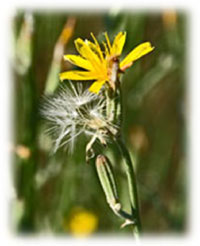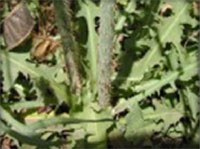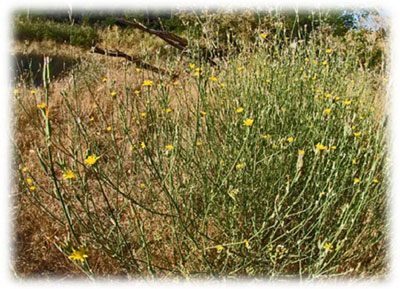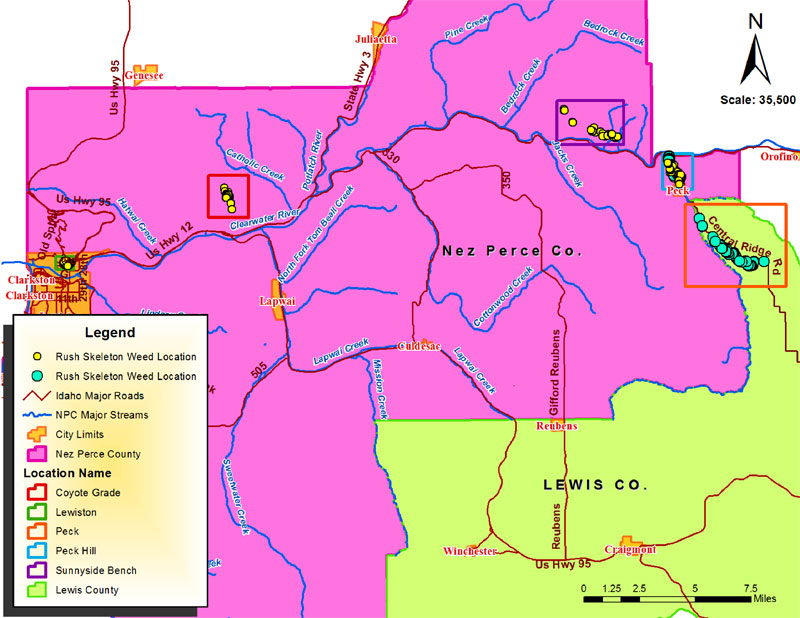Rush skeletonweed (Chondrilla juncea) is an invasive plant in the western United States. It is a native of Central Asia and the Mediterranean and was first detected near Spokane, Washington in 1938. It was found in Idaho and Oregon during the 1960s. For more information on this invasive species go to the National Invasive Species Information Center. Information for rush skeletonweed was adapted from the Idaho Weed Awareness Campaign’s web site.
Rush skeletonweed is a perennial whose branched stems may be 4 feet tall and appear leafless. The lower 4 to 6 inches of the stems are covered with coarse brown hairs. The dandelion-like rosettes, that form in the fall, die as the plant ages. When the plant is cut or broken, it oozes a milky white latex sap.

Figure 1. Rush skeletonweed in bloom. Photo: Idaho Weed Awareness Campaign.
This weed thrives in well drained, sandy textured or rocky soils, along roadsides, in rangelands, pastures and grain fields.
Figure 2. Rush skeletonweed basal leaves and stem. Photo: Washington State Noxious Weed Control Board.

Small yellow flowers begin in early summer and continue until frost in the fall. Seeds mature 9 to 15 days after the flowers open. Each seed has a parachute of fine hairs which allow it to travel long distances by wind.
Rush skeletonweed spreads primarily by seed, but rosettes can form from lateral roots at varying distances from the parent plant.Skeletonweed is difficult to control. It will be necessary to use a number of different control methods.
Figure 3. Rush skeletonweed mature plant. Photo: Idaho Weed Awarness Campaign

Nez Perce County Distribution:
Rush skeletonweed is found within six areas of Nez Perce County. These areas are shown in the map labeled figure 4. Most of the infestations occur along roadsides and rangeland areas.
The weed will establish on well-drained, rocky or sandy-textured soils in climates that are cold in winter, warm in summer, and wet early in the year. The weed is commonly found along transportation corridors or in areas heavily altered by fire, drought, logging, cultivation, or overgrazing.
Figure 4. Rush skeletonweed distribution in Nez Perce County. Yellow doted areas show distribution areas.

Impacts:
- Can reduce wheat yields by as much as 80%.
- Reduces quality and quantity of forage on rangelands
Biology:
- The plant occurs as a rosette from fall through early spring after germination and emergence and as a 1 to 4 foot tall plant during the summer
- Mode of reproduction: mainly seed
- Plants produce up to a 7 foot long tap root.
- Flower heads develop during the summer and bloom into the late fall until the first killing frost.
CONTROL
Research found that an integrated approach, using plant competition and biological control agents, often results in better control then either method used separately. Herbicide control may vary depending on the biotype of rush skeletonweed.
Mechanical ControlHand-pulling can work for small infestations. Areas must be controlled 2 to 3 times per year for 6 to 10 years to remove seedlings and re-sprouting roots. Removal of deep tap roots is easiest when soils are damp. Mowing plants repeatedly may reduce plants' biomass and seed production but may not provide eradication.
Cultural ControlUsing beneficial forage species for competition will not suppress the dominance of rush skeletonweed. Continual grazing decreases populations while rotated grazing increases populations.
Biological ControlBradyrrhoa gilveolella, or the skeletonweed root moth, was recently approved for release. Adults emerge from exit tubes extending from the plant’s root in May and June. Females are capable of producing up to 300 eggs, laying them in the rosette crown or in the soil. For more information go to the Idaho Department of Agriculture’s web site.
Herbicide ControlPlease refer to the PNW Weed Management Handbook, or contact your county noxious weed coordinator.
References: